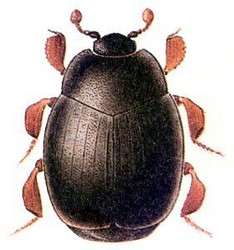Dendrophilini
Michael S. Caterino- Dendrophilus californicus
- Dendrophilus opacus
- Dendrophilus proditor
- Dendrophilus punctatus
- Dendrophilus pygmaeus
- Dendrophilus sulcatus
- Dendrophilus tularensis
- Dendrophilus xavieri
Introduction
Dendrophilini as a taxon is presently in limbo. It has generally been considered to contain two genera, Dendrophilus and Kissister. However, Kissister has recently been shown to be more closely related to Paromalini, leaving Dendrophilini monotypic. Dendrophilus is quite plesiomorphic in the morphology of both male and female genitalia. However, externally it seems to exhibit characters allying it to more derived taxa (particularly Paromalini, traditionally included in the Dendrophilinae).
Dendrophilus is a Holarctic genus, containing 8 species. Most of them are generally associated with decomposing materials, especially compost. However, several species show inquilinism of various sorts. An association with birds’ nests is common in D. punctatus (Halstead, 1963); the American D. opacus was described from a Neotoma (wood rat) nest; and the European D. pygmaeus appears to be an obligate myrmecophile (with Formica rufa).
Characteristics
Species of Dendrophilus share labral setae, a fairly well developed anterior prosternal lobe, and fully exposed antennal cavities with Paromalini, Bacaniini, and Anapleini. The presence of well developed elytral striae separates Dendrophilus from the last two of those. The antennal club of Paromalini has outwardly arcuate annuli, whereas those of the antennae of Dendrophilus are inwardly arcuate.
Discussion of Phylogenetic Relationships
Given the phylogenetically interesting/ambiguous position of Dendrophilus in Histeridae, a careful study of variation and relationships among the known species would be very useful. But aside from a few regional treatments (Ross, 1940; Halstead, 1963; Ohara, 1994), the group has received little significant attention.
References
Halstead, D. G. H. 1963. Coleoptera: Histeroidea. Handbooks for the Identification of British Insects 4:1-16.
Ohara, M. 1994. A revision of the superfamily Histeroidea of Japan. Insecta Mastumurana (N.S.) 51:1-283.
Ross, E. S. 1940. A preliminary review of the North American species of Dendrophilus. Bulletin of the Brooklyn Entomological Society 35:103-108.
Information on the Internet
Masahiro Ohara’s histerid home page: Dendrophilus. (contains photograph of D. xavieri)About This Page

Santa Barbara Museum of Natural History, Santa Barbara, California, USA
Page copyright © 2002
 Page: Tree of Life
Dendrophilini.
Authored by
Michael S. Caterino.
The TEXT of this page is licensed under the
Creative Commons Attribution License - Version 3.0. Note that images and other media
featured on this page are each governed by their own license, and they may or may not be available
for reuse. Click on an image or a media link to access the media data window, which provides the
relevant licensing information. For the general terms and conditions of ToL material reuse and
redistribution, please see the Tree of Life Copyright
Policies.
Page: Tree of Life
Dendrophilini.
Authored by
Michael S. Caterino.
The TEXT of this page is licensed under the
Creative Commons Attribution License - Version 3.0. Note that images and other media
featured on this page are each governed by their own license, and they may or may not be available
for reuse. Click on an image or a media link to access the media data window, which provides the
relevant licensing information. For the general terms and conditions of ToL material reuse and
redistribution, please see the Tree of Life Copyright
Policies.
- First online 07 March 2002
Citing this page:
Caterino, Michael S. 2002. Dendrophilini. Version 07 March 2002 (under construction). http://tolweb.org/Dendrophilini/9387/2002.03.07 in The Tree of Life Web Project, http://tolweb.org/









 Go to quick links
Go to quick search
Go to navigation for this section of the ToL site
Go to detailed links for the ToL site
Go to quick links
Go to quick search
Go to navigation for this section of the ToL site
Go to detailed links for the ToL site